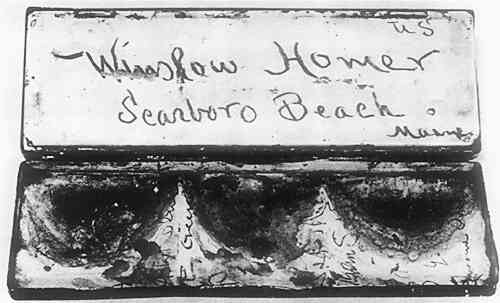ANALYSIS OF WATERCOLOR PIGMENTS IN A BOX OWNED BY WINSLOW HOMERR. Newman, C. Weston, & E. Farrell
THE PRESENT NOTE gives the results of the analysis of nineteen Winsor and Newton moist watercolors (in pans) which once belonged to Winslow Homer. The identification of many of these were previously reported by Craigen Weston,1 and this note represents a completion of her research. The colors are in a box which the artist signed (Figure 1). The box is now in the Homer Collection of the Bowdoin College Museum of Art, Brunswick, Maine. Labels by Homer on either wing of the box (Figure 2) identify pigments but the pans are not presently in the order of the labels. However, all of the legible labels correspond to pigments actually identified in the pans.
Results are summarized in the following table. The sample numbers indicate the locations of the colors in the watercolor box: “R” refers to the right side of the box, “L” to the left; on each side, the colors are numbered from the top to the bottom of the box. A twentieth pigment (between L1 and L2) was not identified. The analytical techniques utilized were emission spectrography, Debye-Scherrer X-ray diffraction and microscopy. In addition, infrared spectroscopy was used with samples R2, R4, R5, and L4, and thin-layer chromatography with the two lakes, L3 and L5. Although the pigments cannot be associated with specific colors sold in the later nineteenth century and the earlier part of this century by Winsor and Newton, all of them were common at that time and appeared in the company's catalogs. The most unusual of the nineteen was L3, a dull violet-brown lake principally of alizarin whose color is perhaps due to a substrate consisting partly of an iron salt. Sample and Color Pigment identification (and composition) R1 BrownBrown earth or burnt umber (calcite, clay, iron oxides) R2 Blue-greenGreen earth (celadonite); bluish tint is due to small amount of Prussian blue, which is probably a contaminant R3 BluePrussian blue (Fe4[Fe(CN)6]3), extended with alunite ([K, DNa]Al3[OH]6[SO4]2) R4 YellowIndian yellow (Mg and Ca salts of euxanthic acid) R5 Dark green‘Hooker's green’ (Prussian blue and gamboge) R6 BlackBone black or ivory black (carbon and β-Ca3(PO4)2) R7 OrangeVermilion (HgS) R8 OrangeVermilion (HgS) R9 Rust orangeBurnt siena, Mars orange, or a similar pigment (hematite, calcite) R10 Orange-yellowCadmium yellow (hawleyite or β-CdS) L1 BrownOrganic brown, possibly Van Dyke brown or Cologne earth (bituminous earth) L2 BrownOrganic brown, possibly Van Dyke brown or Cologne earth (bituminous earth) L3 Dull violet-brownRed lake pigment (alizarin and a lesser amount of carminic acid); substrate possibly contains Al and Fe L4 Yellow-green‘Hooker's green’ (Prussian blue and gamboge) L5 Bright redRed lake pigment (carminic acid and a lesser amount of alizarin); substrate is calcite and possibly also contains Al L6 Brick redRed ochre, Indian red, or a similar pigment (hematite, quartz) L7 OrangeChrome orange(Pb2CrO5) L8 Orange-redVermilion (HgS) L9 BrownOrganic brown, possibly sepia ACKNOWLEDGEMENTSTHE AUTHORS gratefully acknowledge the Bowdoin College Museum of Art, which made the pigments available for analysis. REFERENCER. CraigenWeston, Appendix B (Pigment Analysis), in Marjorie B. Cohn, Wash and Gouache: A Study in the Development of the Materials of Watercolor (Cambridge, Mass: Center for Conservation and Technical Studies, Fogg Art Museum, and the Foundation of the American Institute for Conservation, 1977), pp. 67–70. a: References  Entire Article Entire Article |

